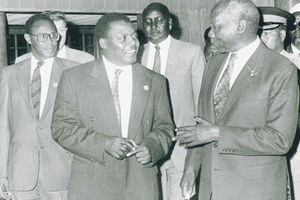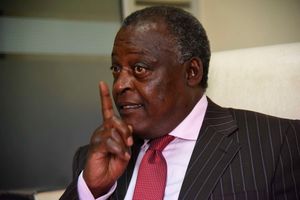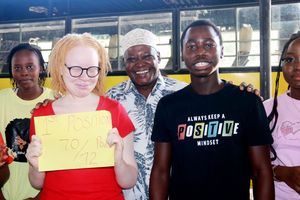Premium
Fresh bid to revive the dying Yakunte language
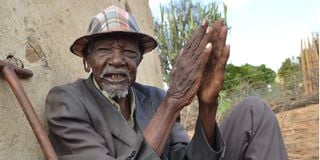
Mzee Stephen Leriman, one of the remaining four elders who can speak the Yakunte language fluently.. Majority of the 7,000 Yiaku community living near Mukogodo forest in Laikipia County do not understand the language of their fathers, having been assimilated to their neighbours, the Maasai community.
In 2010, an initiative to revive the dying Yakunte language was launched, coming a few years after the United Nations cultural agency Unesco declared it extinct.
But these efforts targeting the Yiaku ethnic group failed to make any notable achievement due to lack of interest among locals and the demise of Ms Eunice Sirankasio, who was heading the project.
Around the same time, the Yiaku Cultural Museum that the project leader had helped establish with the objective of reviving the cultural heritage of this community, was also vandalised at the height of conflicts caused by migrating herders from neighbouring counties.
The Yiaku are a Cushitic group bearing great resemblance to the Somali and Borana ethnic groups. They are said to have migrated from southern Ethiopia to the Mukogodo forest in Laikipia County before the arrival of colonialists.
Traditionally, they were hunters and gatherers who lived in caves, deriving their livelihood from forest products such as honey, wild fruits and wild animals. Some of them still live in the Mukogodo forest.
Cultural identity
Over the years, this minority community has lost its cultural identity, including its language, after being assimilated to their neighbours, the Nilotic pastoral Maasai.
Today, only four elders, all in their sunset years, speak the Yakunte language, a situation that puts it on the brink of extinction.
This prospect has provoked a young Yiaku woman to give the revival of the language of her forefathers a new push, targeting both children and adults.
Ms Juliana Kageni, 28, is the youngest person in a population of about 7,000 who can speak the language fluently. About 5,000 people have Yiaku genes but pure ones number about 2,000.
A university graduate who is an unemployed teacher, the young woman is among 13 individuals who relaunched the Yiaku Cultural Museum earlier this year, with a simple wooden structure serving as a classroom for her current 258 registered learners.
The museum will be a resource centre where researchers will have an opportunity to learn about the history of one of Kenya’s hunter-gatherer communities.
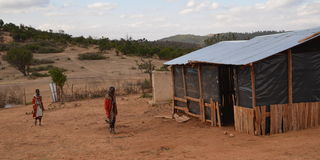
Women from the Yiaku community in Laikipia North Sub-county head for Yakunte language lessons at Kuri Kuri Culture Centre and Museum.
“A total of 200 adults are currently attending my lessons, which I conduct on Wednesdays and Saturdays. The 58 children attend Yakunte language lessons on Saturdays between 10am and 11am,” said Ms Kageni, adding that when she decided to join a teachers training college, she knew her skills would one day come in handy to benefit her community.
Great work
One of her students is a former civic leader, Mr John Parmashu, who has hailed this new initiative, saying he has also enrolled his children to study the language.
“The young teacher is doing some great work. We are hopeful that this time we shall manage to have many members of our community speak this language and eventually we shall reclaim our lost identity,” the former councillor in the defunct Laikipia County council told the Nation.
Another student is Mr Lpirinkis Leitiko, 55, who proudly stated that after attending several lessons, he could construct a complete sentence in the Yakunte language, something he had not been able to do.
“I am looking forward to the next market day here in Dol Dol town. I will stand up and tell those who have been despising us as a people without culture that we have finally reclaimed our lost language,” said Mr Leitiko.
Beside the physical interaction with learners, Ms Kageni has also started a WhatsApp group for those in far-off places and it has 53 members.
Yakunte dictionary
“My main tool for teaching my students is the Yakunte dictionary, where words are translated to the Maasai language. For the members in the WhatsApp group, I conduct a one-hour lesson in the evening where I guide them on proper pronouncements of the words,” she explained.
The Yakunte dictionary was produced in 2007 by Dutch researcher Fleur Wensveen with help from one of the seven fluent speakers of the language at the time. Three of them have since died.
The large enrolment of interested learners indicates that the notion that the Maasai language is superior is slowly losing meaning.
When the first learning centre was established in 2010, the late Ms Sirankasio confessed to having challenges in enrolling learners, with many preferring to speak in Kiswahili instead of the community’s indigenous language.
“We still consider our language inferior to the Maasai and I am sure even if the language was to be taught in schools, many would still prefer to speak Kimaasai and Kiswahili,” Ms Sirankasio told the Nation at the time.
Ms Kageni has joined hands with her elder sister, Ms Rachel Malka, who has also learned the language, and both occasionally visit Kuri Kuri and Bokish primary schools to teach pupils when school administrators give them an opportunity.
The two sisters and 11 other volunteers have been donating their time and resources to this new initiative and have appealed to the Laikipia County government to allocate funds for the project through the department of Sports, Culture and Social Services.
How did the young woman learn the language when most other people around them spoke only the Maasai language?
Fourth-born
“I have lived with my grandparents since I was seven years old after my dad passed on and my mum went back to her parents’ home, though she also died in 2013,” said the fourth-born in a family of seven.
“My grandparents are among the four remaining elders who can speak Yakunte and they taught me the language.”
Ms Kageni’s grandfather, Mzee Stephen Leriman, is the oldest among the remaining four elders, with his age believed to be 101. Others are Mzee Leriman’s wife Rebecca, Mzee Supeto Leitike and Mzee Leteyion Tuta, all in their 90s.
“My aging grandfather is very keen on seeing that we reclaim not only our lost language but our culture and traditions as well, which have been eroded. He is the one who donated one acre of his land for us to put up the cultural centre and museum,” Ms Kageni explained.
Other Kenyan languages listed by Unesco as critically endangered include Terik, El Molo, Ogiek, Omotik, Bong'om and Sogoo.
Unesco says that moribund or even extinct languages can be saved through determined policies and cites the example of Japan, where Ainu, spoken by only eight people on the island of Hokkaido in the late 1980s, is being revived.
The report on the Unesco website says that sometimes languages that have actually died have been “raised from the dead,” such as Cornish, in England, which became extinct in 1777 but has been revived in recent years, with nearly 1,000 people now speaking it as a second language.
Former Unesco director-general Koïchiro Matsuura once said: “All languages are given equal recognition, for each is a unique response to the human condition and each is a living heritage we should cherish.”



